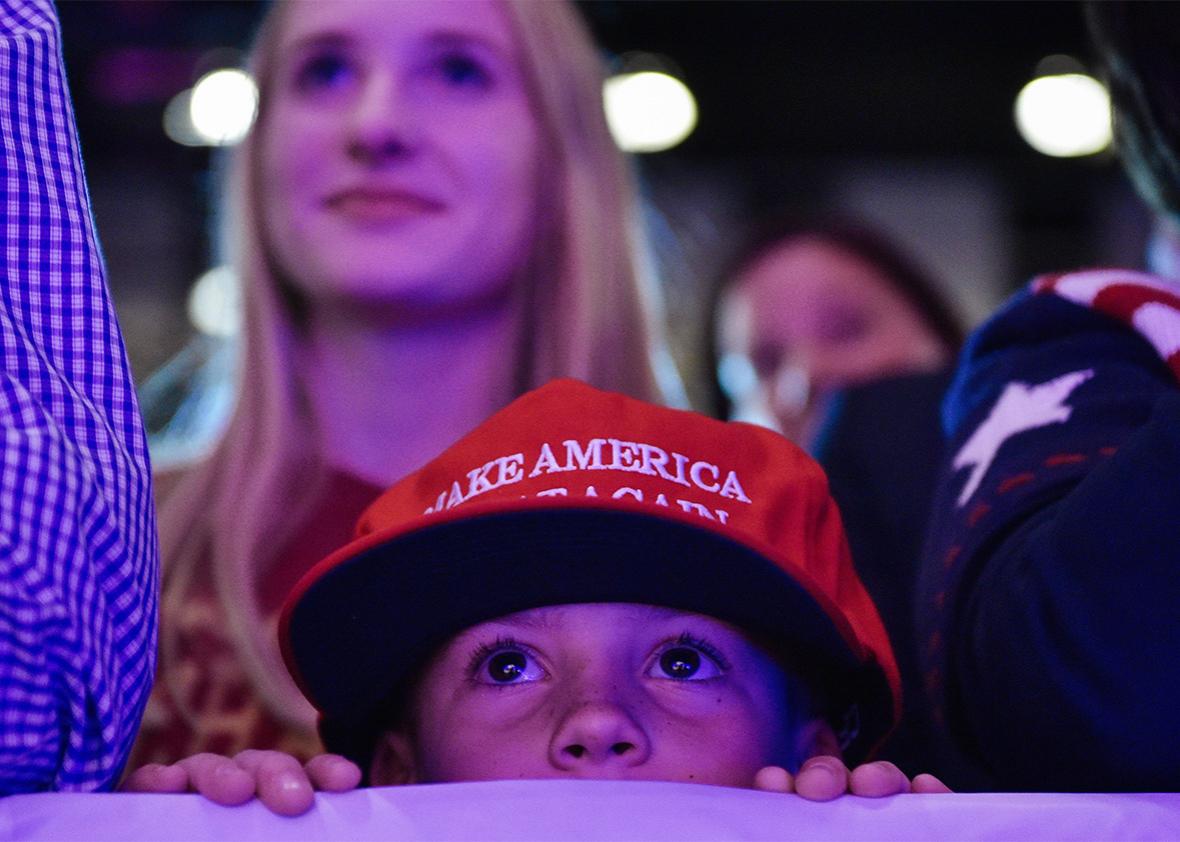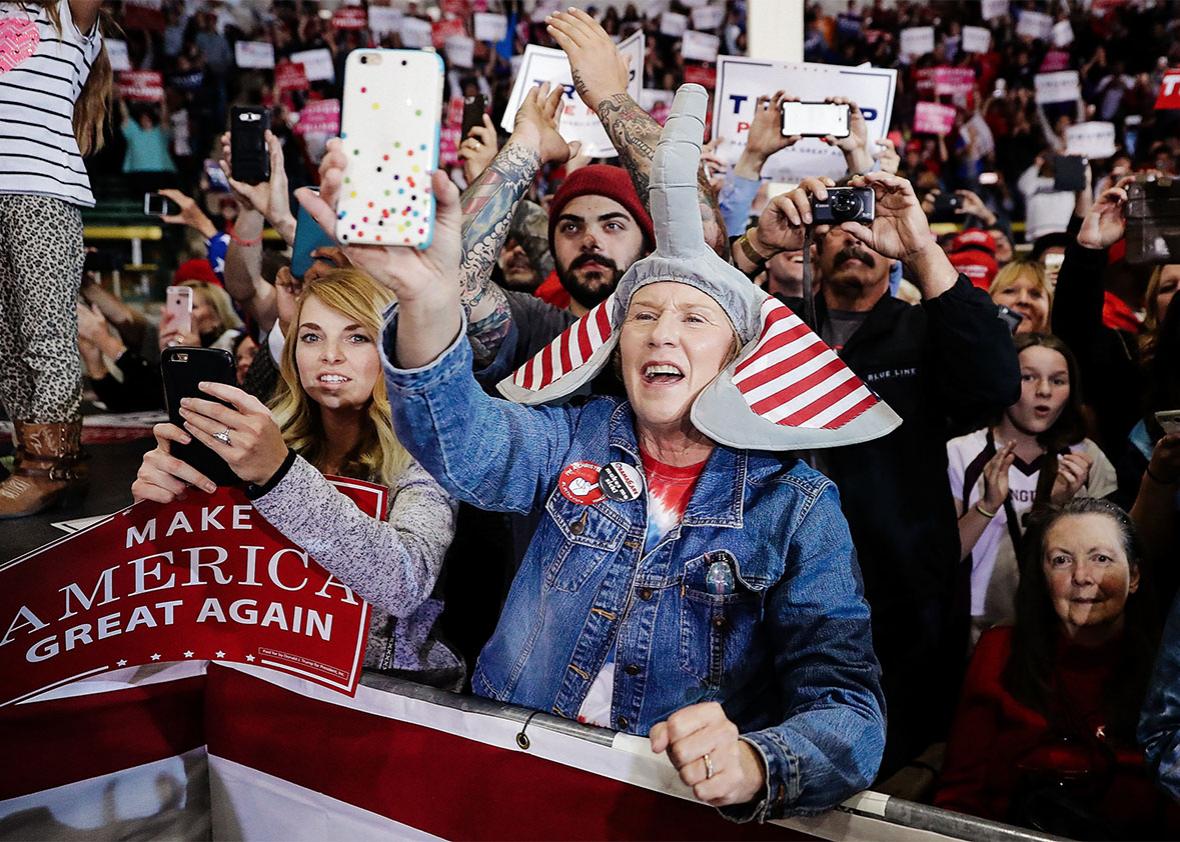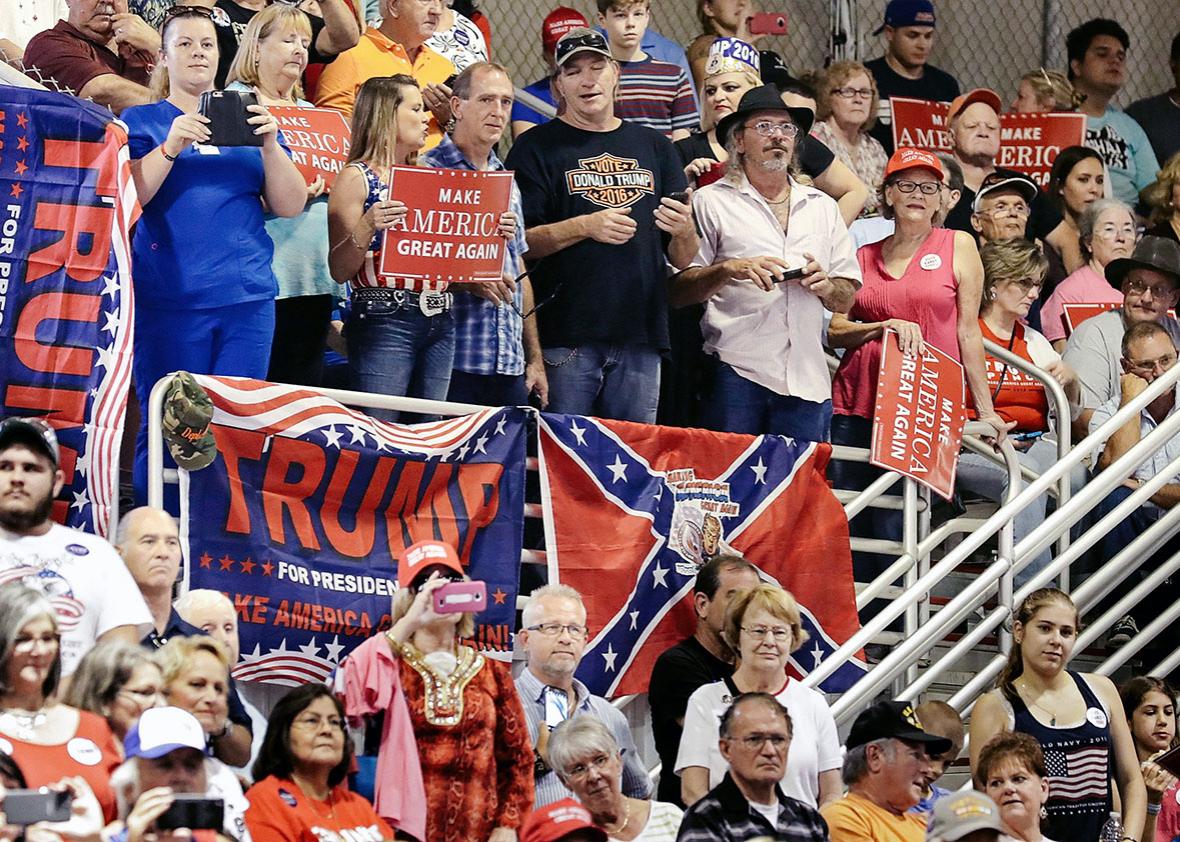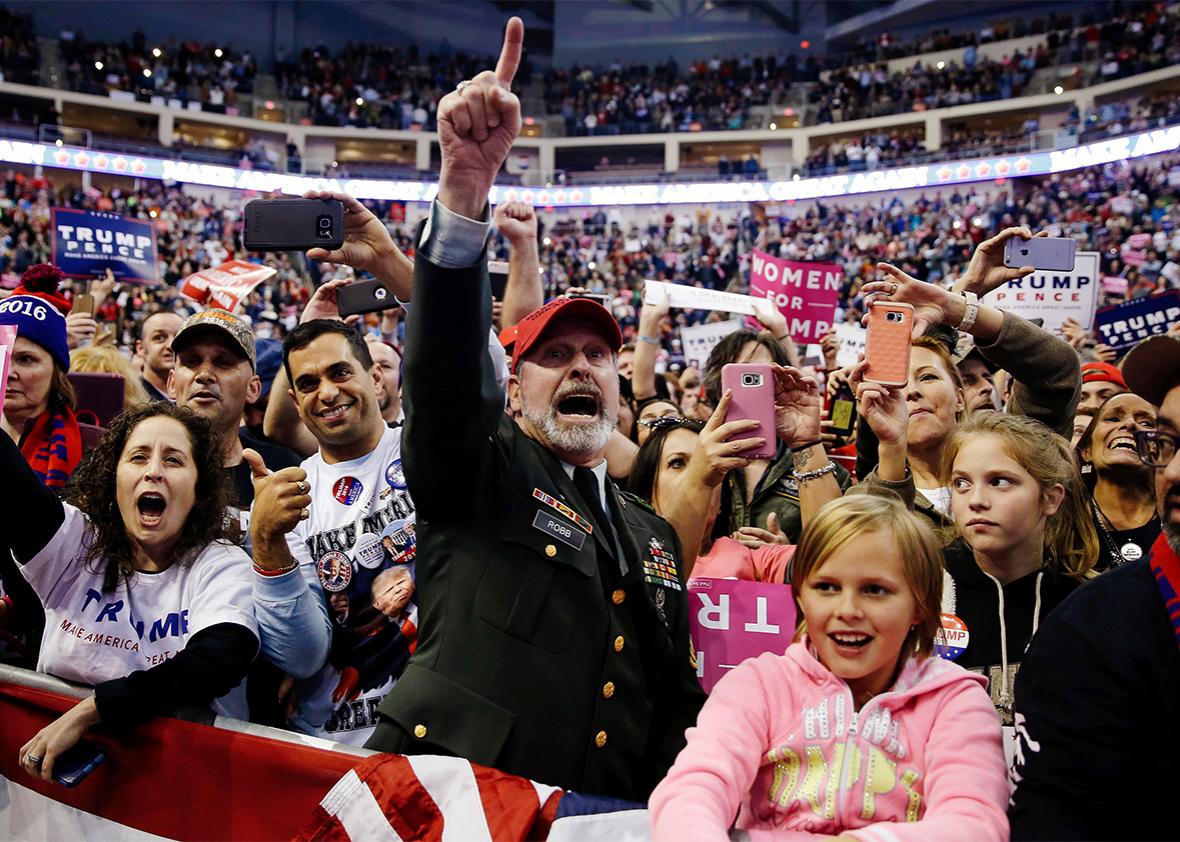I thought I’d gone out on the campaign trail to witness Donald Trump’s funeral. To delight in his comeuppance. To observe his passionate fans’ last moments in the sun, and to suss out where Trump’s true believers would turn in the throes of postelection despair.
Things didn’t turn out as planned. I’ll leave it to others to determine how Trump won. All I can report is what I saw from the most excited, energized chunk of his base. The adoring fans who stood in endless lines outside rallies, shuffling through the hot midday sunshine or the shivery nighttime cold. The red-hatted masses who packed drafty airport hangars and musty minor league hockey rinks—all because they hated me, and maybe you, too.
* * *
Monday, the last day of Trump’s 2016 campaign, began with a typical rally in Sarasota, Florida, in an arena thundering with chants of “Lock her up” and “CNN sucks.” I was huddled in the media pen with the traveling press, awaiting the moment Trump would point at us and incite his 5,000 minions to jeer. When the boos did rain down, they were as loud as I’d ever heard them—home stretch, final sprint, leaving-it-all-out-there boos. Trump pushed the same button again minutes later, and the boos were louder still. One lady leaned up against the pen’s barrier, flashing double-thumbs-down and a disquieting scowl.
When Trump arrived at the line in his stump speech about “the first 100 days of the Trump administration,” it was the press pack’s agreed-upon cue to gather up laptops and cameras and hustle onto the bus idling outside. We motorcaded through the streets with police lights twirling at every corner, slowed to a stop on the airport tarmac a few yards from the rolling staircase, scrambled aboard the charter 737, and roared aloft within moments.
So began a five-state, 15-hour, end-game dash. Raleigh, North Carolina. Scranton, Pennsylvania. Manchester, New Hampshire—where the entire Trump family took the stage amid laser lights and smoke. And then the last, postmidnight rally in Grand Rapids, Michigan. The identical routine each time: wheels down, motorcade to event, security herds us into the pen. Sit through boos from the crowd and ridicule from the stage. Security herds us out, back to the plane, wheels up, repeat.
By the third rally of the day, I’d begun to question why we were there. Yes, reporters were dutifully recording Trump’s outlandish promises, shameless untruths, and ignorant fuck-ups. (Unless they weren’t worth the ink amid the other, bigger fuck-ups. At one point on Monday, Trump referred to Haitians as Hispanics—a flub that I think went unreported but might have dogged Mitt Romney for half a news cycle.) Still, any Americans who hadn’t yet cared about this shit weren’t going to start now.
No, there was something else. An uncomfortable suspicion taking hold in me. I became convinced we weren’t at these rallies to observe. We were there to be observed.

Mandel Ngan/AFP/Getty Images
Ever since the first Trump event I attended back in March, I’d wondered why his campaign was so intent on impounding us inside these press pens during his speeches. Was it to prevent us from speaking to rallygoers? If so, it was ineffective—you can chat with them all you want before or after the event or by beckoning them to the edge of the pen. Maybe it was meant to keep us from filming protesters up close? Again, didn’t work, as violent abuse of these dissenters was caught on camera again and again. The campaign itself has always claimed it was a security protocol, which made little sense, as everyone inside the venues has been swept by Secret Service—and if journalists can handle war zones, they can handle a little shoving.
Perhaps I’d been naïve, but it only now dawned on me, in the final week of the campaign, to my great horror, that the real reason they put us in the pen was so they could turn us into props. We were a vital element in Trump’s performance. He never once failed to invite his crowds to heckle us. He was placing us on display like captured animals.
And it worked. The press pack, collectively, looked nothing like the crowds at Trump events—particularly in more rural towns. We’d file into these places with our sleek luggage and our expensive tech gear and our better haircuts. We were far more diverse than the people in the stands. When the crowds lustily booed us, we’d sit there impassive and stone-faced, and this only further served to convince the rallygoers that we were snobby, superior pricks. The pen was an amazingly efficient means of othering us.
Behold, Trump said to his fans, I’ve rounded up a passel of those elites you detest. And I’ve caged them for you! Allow me to belittle them for your delight. Here, now you take a turn—go ahead, have at it! Do it again, don’t be shy! Under President Trump, the other elites will be in cages, too. We’ll lock them up, just like the chant goes. Just like you wanted. You’ll be their captors.
In retrospect, this was the core message of Trump’s campaign.
* * *
It’s so tempting to reduce Trump diehards to an angry composite. But each time I met individual rallygoers—I saw Trump speak in about 20 cities over the course of the campaign and would guess I’ve interviewed at least 200 people at his events—I’d be reminded that Trump’s core is in fact an angry tapestry. In Denver alone, I met a woman who’d gone to Caltech and had a Ph.D. in planetology; a man who was a director-level executive at a medical devices company; another fellow who was a V.P. of finance at a college. There were plenty of women, a fair amount of Latinos, and a handful of blacks. (The very first Trump supporter I interviewed, back in March, was a black woman who buttonholed me to say, “Donald Trump tells the truth.”)

Chip Somodevilla/Getty Images
There’s no denying racism is in the mix at Trump events. You’ll very rarely hear it explicitly stated (except maybe from the man on the stage), but you’ll hear a lot of coded language. The thing is, there has always been coded language coming from the right. In 2012, it was “lazy takers” mooching off “makers.” In 1988, it was Willie Horton coming for your family.* In 1980, it was the proverbial “welfare queen.”
The flood of Islamophobia this year, spurred by fear of terrorism, does feel new and is horrifying. (In Hershey, Pennsylvania, on Nov. 4, I spoke to a military vet who said, “We need to nuke the Muslims before they nuke us, or one morning we’re gonna wake up and New York and Tel Aviv are gonna be vaped.”) But from my own experience interviewing the hardcore Trump ride-or-die’ers at rallies, I just don’t think this was the driving emotion behind their entrancement.
Nor do I think it was all about NAFTA and TPP for the in-the-tank Trumpers. Not a single Trump supporter I spoke to, even at the Rust Belt rallies, brought up protectionism. They might say Trump will “bring our jobs back,” but they mean that in a general sense—they believe he’s a brilliant businessman with a nose for economic success. I honestly think Trump might have done just as well with these folks had he never mentioned NAFTA and simply promised, in his vague way, to get the economy humming again. His campaign was in no way about policy. It was the singer, not the song.
The one notion shared by every wildly enthusiastic Trumpist I met—both in my earlier stint covering his campaign and in this last week on the trail—was a firm conviction that Donald Trump is on their side in a war against elites. That he’d fight for them in their battle against the preppy eggheads who run the government, the financial system, and the media. I heard it over and over.

Chip Somodevilla/Getty Images
On Nov. 2 in Orlando: “He’s being honest about what’s going on behind the scenes. There’s so much corruption. I think even if he loses we have an awareness of that corruption now.”
On Nov. 3 in Jacksonville, Florida: “He’s not an insider politician. He’s gonna change stuff up. That’s what we need. No more insider deals in politics.”
On Nov. 4 in Hershey: “Donald Trump isn’t the establishment. I voted for Obama because he said he’d get rid of lobbyists, but he didn’t. Trump really is a people’s revolution.”
On Nov. 5 in Denver: “Fuck the federal government. Fuck them all. I have friends that are planning a tax revolt. I’ll move to the first state that secedes.”
A Rand survey in January, prior to the primaries—before Trump’s bandwagon had swelled with reluctant Republicans who’d preferred Marco Rubio or Ted Cruz—found that one criteria above all others predicted support for Trump (emphasis mine):
Among people likely to vote in the Republican primary, people are 86.5 percent more likely to prefer Donald Trump as the first-choice nominee relative to all the others if they “somewhat” or “strongly agree” that “people like me don’t have any say about what the government does.” Using statistical techniques, we can conclude that this increased preference for Trump is over and beyond any preferences based on respondent gender, age, race/ethnicity, employment status, educational attainment, household income, attitudes towards Muslims, attitudes towards illegal immigrants, or attitudes towards Hispanics.
The foundation of Trump’s movement is distrust of elites. It’s why Trump calls the system “rigged.” It’s why his closing pitch was “Drain the swamp.” It’s why he always makes sure to note that he was once “a great insider,” but now he’s “the ultimate outsider”—one who has no truck with the GOP establishment, one who talks like his supporters and not like a poll-tested bot. It helps explain why anti-Semites flocked to his movement, in the belief that Trump would bring down a sinister ruling class. It’s why, unable to trot out bankers from Goldman Sachs, he relied on the media to play villain. It’s also why Hillary Clinton was the perfect patsy to take an electoral fall. “Hillary says she’ll raise taxes on rich people,” said a 53-year-old woman in Hershey, “but I can’t see her doing that when the rich people are her friends.”
* * *
Trump wrapped the final rally of his campaign in Grand Rapids, in the wee hours of Election Day. And as we boarded our last charter flight, the mood in the press pack got loose and giddy. Champagne flowed as reporters tore down the tchotchkes they’d affixed to the airplane’s walls—their small effort to make this space they’d spent so much time in a bit more homey. Someone sledded down the aisle on a food tray as the plane’s nose elevated, speeding us away from the Rust Belt and back to glimmering New York. I can’t speak for everyone, but I’d assumed—thanks to the egghead pollster elite—that Clinton had the presidency in the bag.
The plane landed in Newark around 3:30 a.m. As we loaded onto the charter bus to Manhattan, sleepy and tipsy, it was noted that Trump, to the very end, had never acceded to long-standing tradition by allowing the press pool on his own plane. There was also grousing about a minor but telling indignity: He hadn’t deigned, as every other candidate in memory had, to take an end-of-campaign group photo with his press pack.
I got back to my Brooklyn apartment around 5 in the morning. Hours later I saw all the same reporters at the Trump election night party, ashen-faced and tight-lipped. As we began to realize we weren’t done dealing with the least press-friendly candidate in history—that we’d be dealing with him for another four years, only now he’d be far more powerful—there were no angry throngs around to point and scream at us.

Ricky Carioti/Washington Post via Getty Images
Instead, the luxe ballroom at the Midtown Hilton swelled with fancy people in suits and dresses. I talked to some bankers, and a lawyer, and a guy who ran golf courses for the Trump Organization. Their red “Make America Great Again” hats were jaunty, one-night-only accessories to their cocktail attire—not the deeply felt uniform of the folks at Trump’s rallies. Gazing around at the gilded scene, a feeling bubbled up within me. It was hatred of elites.
And as Trump took the stage to bask in his victory, I felt something else, too. Pity for the small-town Trumpists who thought they voted for one of their own but elected a man who mingles solely with rich assholes. Pity for the plutocrat-haters who’ve now ensured sweeping deregulation of financial institutions. Pity for the salt-of-the-earthers who are sick of Washington corruption yet elected a man who will surely preside over the most corrupt administration imaginable. Pity for all those excited rallygoers duped by a con man—an elite in sheep’s clothing.
Correction, Nov. 14, 2016: This piece originally misstated that the Republican Party used coded language about Willie Horton against Democrats in 1992. It was in 1988. (Return.)
